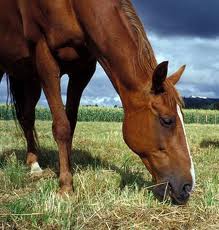 1. The first thing is to check the horses' appearance. Are they too skinny
or too fat? You should not be able to see the ribs, but you SHOULD be able to feel them easily through the
skin. If you can't the horse is too fat.
1. The first thing is to check the horses' appearance. Are they too skinny
or too fat? You should not be able to see the ribs, but you SHOULD be able to feel them easily through the
skin. If you can't the horse is too fat.
2. Do you notice any limping or other unsoundness? Definitely avoid buying a
lame horse.
3. Though this may seem foolish, look at the horse and see if there is
anything in the expression that gives you a reason to pause or hesitate. If there is, move on. You want a horse
that you're completely comfortable with.
4. Check his attitude. He should be pleasant and relaxed. If the horse appears
angry or in pain ask why.
5. Does the horse look tired or lethargic? Are they a bit wild and untamed?
You want a horse that is calm and gentle around you, not lazy or wild.
6. Check the hooves. You want the hooves to be in good condition as poor hoof
care can lead to lameness which can be expensive to fix and very painful for your horse. Avoid buying any horse
that has hooves in poor condition.
7. Take a look at the overall appearance of the horse. The build is important!
The horse should look well balanced. If you are unsure, take someone with you that knows horses well to help
you decide.
8. How does it treat you when you're standing on the ground? You want a horse
that is polite, ALWAYS.
9. Ask to groom the horse so you can observe how it behaves. Note any
ticklishness, head shyness. How does it behave when you go to clean the hooves? You want to be careful that the
horse isn't trying to crowd you out or kick you while you're trying to groom.
10. How does the horse behave when led? You want an animal that obeys commands
such as walk, trot, stop, back up and turn. If possible, have the horse trot on a hard surface so you can get a
better look at any possible lameness.
11. Watch the horse be saddled and bridled. Note any meanness or stubbornness
that occurs once it has been bridled.
12. Watch the horse be handled by a rider. Ask to see walking, trotting,
stopping and any show moves if the horse is being purchased for showing purposes.
13. Mount the horse yourself and see how it responds to you being the rider.
How are its manners? Does it hold still while you mount and dismount? Do some riding at different speeds, does
it respond well and without trouble? If you're buying the horse for a show purpose, do some practice and see
how you get along.
14. Make sure, if you want the horse, that you get the papers from the seller.
If you do not have the papers then the horse is not legally yours!
15. Shop around. Don't purchase the first horse you see. See a few horses,
compare them all with the same criteria and then buy the horse that suits you best. If you are at all unsure,
take a professional with you to help you evaluate the horse.
Related Articles
5 Most Common Horse and Rider Communication
Mistakes
Basic Horse Anatomy
Cost of Owning a Horse
Top Five Dressage Breeds
The Five Best Breeds for Beginners
Working Cattle With your Horse
How To Sell Your Horse
Miniature Horse FAQ
The Top Five Pony Breeds
What to Look for When Buying a Horse
Top Five Work Horses
20 Questions to Ask Before Buying Your Horse
Top Five Western Show Breeds
Top Five Breeds for Jumping
Important Questions to Ask Your Horse
Trainer
What Kind of Horse is Right for You?
Deciding on the Right Blanket for Your
Horse
The Pros and Cons of Shopping for Horse
Equipment Online